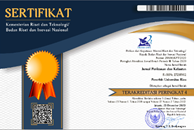Diversification of Processing of Cock Fish Bone Chips (Channa striata) with Different Compositions
(1) Prodi Ilmu Perikanan, Fakultas Perikanan dan Kelautan, Universitas PGRI Palembang
(2) Prodi Ilmu Perikanan, Fakultas Perikanan dan Kelautan, Universitas PGRI Palembang
(3) Prodi Budidaya Ikan, Fakultas Perikanan dan Kelautan, Universitas PGRI Palembang
(*) Corresponding Author
Abstract
Processed fishery products produce unwanted materials, namely waste. Waste is generated in the form of heads, tails, fins, bones, and offal. Bone is one form of waste generated from the fish processing industry which has the highest calcium content in the fish body. Snakehead fish bone waste (Channa striata) is one of the potential food ingredients that is widely used in South Sumatra, especially in the city of Palembang as a raw material for processed Palembang specialties. Diversification of processed fishery products needs to be developed. In this study, the authors innovate processed products made from cork fish bones to increase the nutritional value of the community through protein and fish calcium in the form of processed products of cork fish bones chips. This research was conducted from April to June 2021. This study aims to determine the effect of using the addition of cork fish bones in the manufacture of fishbone chips with different compositions and to obtain the best chip products from the use of s cork fish bones. The method used was an experiment using a Completely Randomized Design (CRD), with 4 levels of treatment P0:0% (Without the addition of cork fish bones and 300 g of Wheat Flour) P1:20% (60 g Addition of cork fish bone and 240 g of Wheat Flour). ) P2: 25% (75 g cork fish bone and 225 g Wheat Flour), P3: 35% (105 g cork fish bone and 195 g Wheat Flour). The parameters measured in this study were organoleptic tests (appearance, aroma, taste, and texture) and proximate tests (moisture content, protein content, fat content, ash content, and carbohydrate content). The results showed that the best treatment on the P3 chips treatment: 35% (105 g Addition of Cork Fish Bone and 195 g Wheat Flour) including the best organoleptic average values obtained in color (58.0) Aroma (60) Taste (52.5), and Texture (59.5). Chips P3: 35% (Addition of Cork Fish Bone 105g and Wheat Flour 195g) including proximate test, average water content is 3.09%, protein content is 18.68%, fat content is 28.81%, ash content is 6.30 %, and carbohydrate content is 43.12%.
Keywords
Full Text:
PDFReferences
Aini, Q. H. 2014. Kadar Air dan Kadar Abu. Universitas Jendral Soedirman
Aisyatussoffi, N., dan N. Abdulgani. 2013. Pengaruh Pemberian Ekstrak Ikan Gabus (Channa striata) pada Struktur Histology Pancreas dan Kadar Glukosa Darah Mencit (Musmusculus) hiperglikemik. Jurnal Sains dan Seni Pomits. 2(1): 2337-3520
Antara, N, dan Wartini. 2014. Aroma and Flavor Compounds. Tropical Plant Curriculum Project. Bali : Udayana University.
Handayani, D.I., dan Kartikawati, D. 2014. Stik Lele Alternatif Diversifikasi Olahan Lele (Clarias sp) Tanpa Limbah Berkalsium Tinggi. UNTAG Semarang.
Midayanto, D. N., dan Yuwono, S. S. 2014. Penentuan Atribut Mutu Tekstur Tahu untuk Direkomendasikan sebagai Syarat Tambahan dalam Standar Nasional Indonesia. Jurnal Pangan dan Agroindustri. 2(4) :259-267.
Noviyanti, S. Wahyuni, dan M. Syukri. 2016. Analisis Penilaian Organoleptik cake Brownies subtitusi Tepung Wikau Maombo. Jurnal Sains dan Teknologi Pangan. 1(1): 58-66
Nuryanti, Y., Y. Rusman, dan Sudrajat. 2017. Analisis Biaya, Pendapatan dan R/C Agroindustri Keripik Pisang. Jurnal Ilmiah Mahasiswa Agroinfo Galuh. 4(3) :396-401.
Putra. M.R.A, Nopianti. R, Herpandi. 2015. Fortifikasi Tepung Tulang Ikan Gabus (Channa striata) pada Kerupuk sebagai Sumber Kalsium. Jurnal Teknologi Hasil Perikanan. 4(2):128-139
Salamah, E. dan Hendarwan, Y. 2004. Studi Tentang Asam Lemak Omega 3 dari Bagian-Bagian Tubuh Ikan Kembung Laki-Laki (Rastrelliger kanagurta). Buletin Teknologi Hasil Perikanan 8(2).
Saputra, R., I. Widiastuti, dan R. Nopianti. 2016. Karakteristik Fisiko-Kimia dan Sensori Kerupuk Pangsit dengan Kombinasi Tepung Ikan Motan (Thynnichthy sthynnoides). Jurnal Teknologi Hasil Perikanan 5 (2): 167-177
Sari, A.T. 2019. Pengaruh Penggunaan Campuran Daging dan Tulang Ikan Sembilang (Paraplotosus albilabris) pada Pembuatan Stik Ikan Terhadap Penerimaan Konsumen. Jurusan Teknologi Hasil Perikanan dan Kelautan Universitas Riau
Standar Nasional Indonesia 01 -2713.2000. Kerupuk Ikan. Dewan Standardisasi Nasional. Jakarta: Departemen Perindustrian.
Sumantri, A. 2013. Kesehatan Lingkungan. Prenada Media Grup. Depok
Winarno, F.G. 2004. Kimia Pangan dan Gizi. Gramedia Pustaka Utama. Jakarta
Article Metrics
Abstract view : 229 timesPDF - 140 times
DOI: http://dx.doi.org/10.31258/jpk.27.2.164-173
Copyright (c) 2022 Fuji Astuti, Fitra Mulia Jaya, Lia Perwita Sari

This work is licensed under a Creative Commons Attribution-NonCommercial-NoDerivatives 4.0 International License.
Gedung Marine Center Lt 2. Fakultas Perikanan dan Kelautan Universitas Riau



